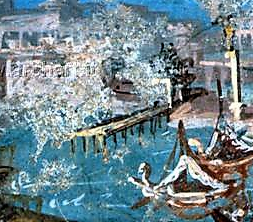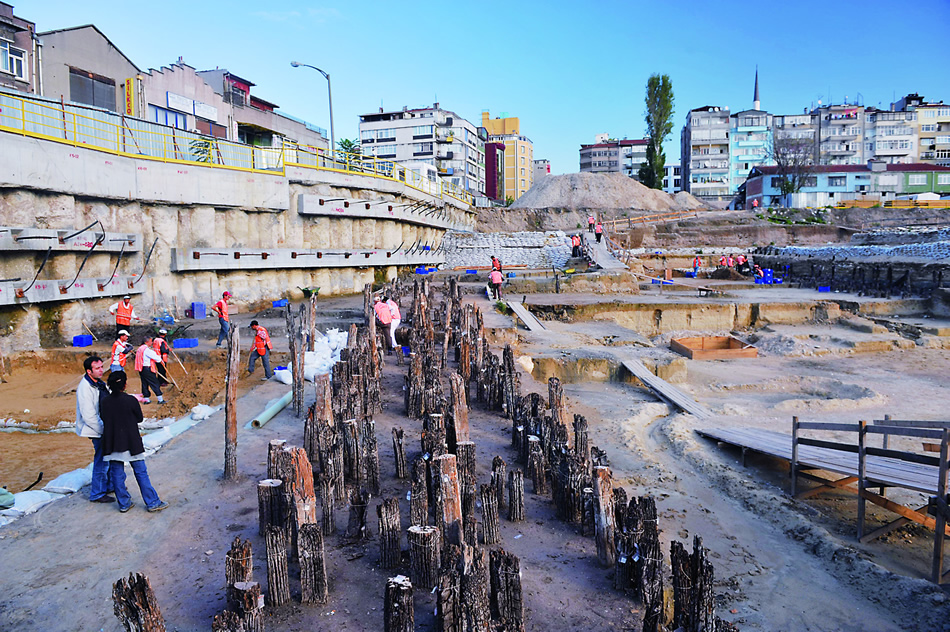Homer repeatedly mentioned beaching ships (Odyssey, 13, 113-115). In Odysseus’ time, the ships may have been of the eikosoros-type, with two files of 10 rowers, or a ‘triaconter’ (triakontoros) with two files of 15 rowers, a length of around 20 m and a weight of less than 10 tons.
It is worth comparing this to Senegalese traditional fishing boats (“pirogues”). Most of these boats are 10 to 20 m long with a 1 to 4 m beam. They are made from a single tree-trunk (monoxyle pirogues) which is enlarged by lateral planks. Considering the rather rough Atlantic wave climate, one of the questions is how fishermen operate to land on and to leave from the beach. Pictures from Franck Boyer (Kamikazz Photo agency, Dakar) give some clues:
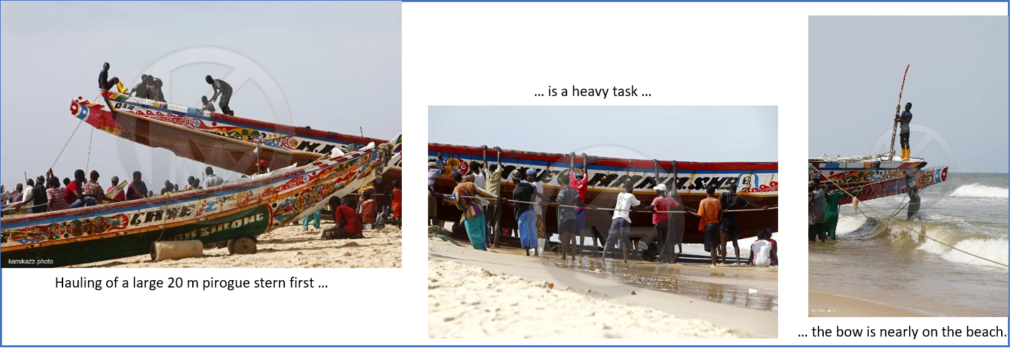
A nice time lapse of the hauling operation, which took around 3 hours, is shown on: https://www.youtube.com/watch?v=kXLDRCjTuBA
Rankov (2012) explains that it was possible to haul a 25-ton (light ship) trireme on a slipway in a harbour with a team of 140 men, provided the slipway had the correct slope (say no more than 1:10, or 10%, or 6°) and was adequately greased. However, he considers that “it is hard to see that triremes would have been beached except from necessity”. This can be understood because the friction on the beach is higher than on a greased slipway. In addition, the beach slope depends on its grain size (Komar, 1998): the very fine sands (or silts) found in large deltas yield a very flat slope which keeps ships far from land. Conversely, a shingle beach (e.g. Nice, France) has a steep slope that is dangerous for landing ships on.
Hence, with increasing ship sizes (and weights), beaching became un-practical, if not unfeasible, and places for safe anchorage were sought.
Greg Votruba (2017) provided convincing argumentation that cargo ships did not habitually beach and concluded that “from the Classical period at the latest, the standard practice was to remain afloat at anchor”.
From our Catalogue, we know that for nearly 6000 ancient coastal settlements, ports and harbours, we have around 950 ports (only 16%) with some kind of ancient port structure such as breakwaters and quays.
Only three options were therefore available for loading and unloading ships outside of a port with heavy infrastructures:
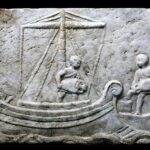
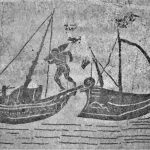
- Stay offshore at anchor and load/unload by means of small barges, as mentioned by Strabo for Ostia (Geography, 5, 3, 5), by Pliny the Elder for Muziris (Natural History, 6, 26, 10) and by Isidore of Seville (Etymologiae, 19, 1, 19). This option may also have been chosen at Ashkelon (Galili, 2021).
The left mosaic shows transfer of amphorae from a large sea-going ship to a smaller river ship.
The right mosaic shows a man on a smaller river ship transferring the content of an amphora into a barrel, perhaps a measuring module. The man on the larger sea-going ship waits for the next amphora to be transferred, and for taking back the empty amphora. This relief possibly shows an example of reuse of amphorae. - Draft-beach and load/unload by means of labourers wadding between the beach and the ship, as shown on a famous mosaic found at Sousse (Tunisia).
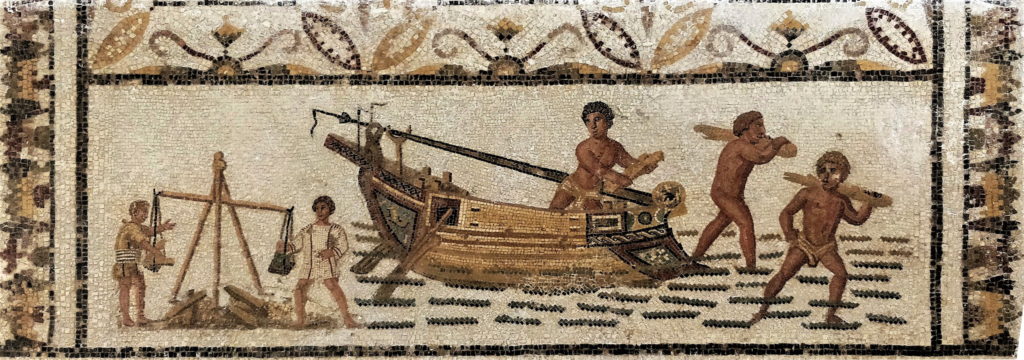
Picture by A. de Graauw, 2018, Bardo Mus, Tunis.
The mosaic above shows a draft-beached ship, i.e. resting gently on the seabed at its bow, with its stern still afloat. This is the closest to the beach a ship can get without getting stuck (in a place without any tide). A very similar operation is performed by Senegalese fishermen unloading their ship before hauling it on the beach.
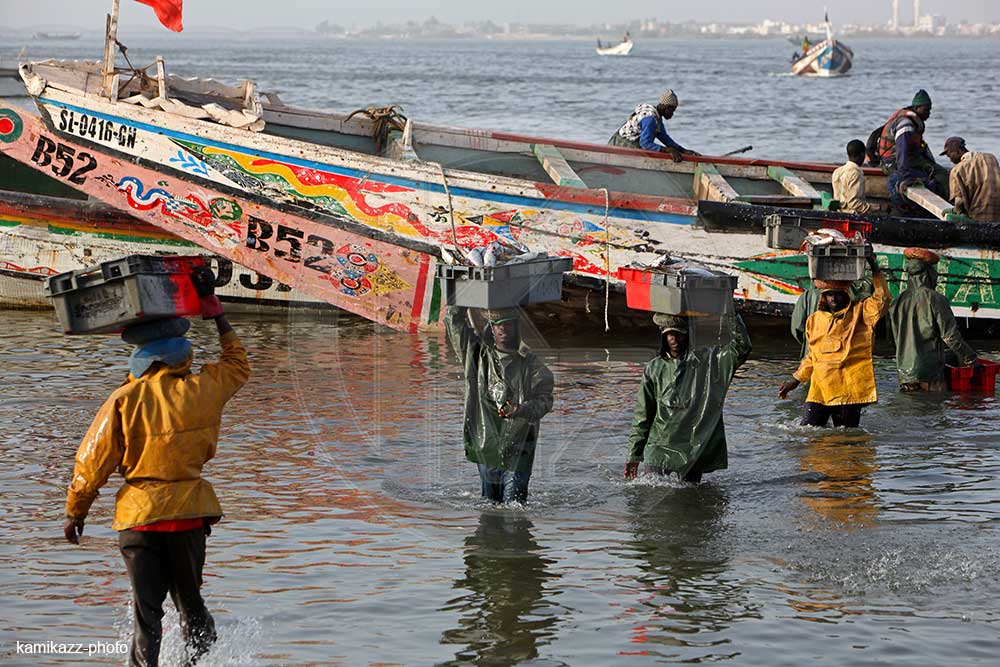
Picture by Franck Boyer (Kamikazz Photo agency, Dakar).
3. Moor at some kind of wooden jetty built on the coastline, as shown on the famous Stabiae fresco.
Ancient wooden piled jetties have been built in many places, but few remains have been found. Recent archaeological excavations at Yenikapi (Istanbul) have uncovered a large piled wooden jetty with three rows of piles. A similar wooden piled jetty with three rows of large piles was also found in Marseille in front of the dolia horrea and in Bordeaux. Outside such large ports, much smaller wooden jetties must have been built in many places.
An ancient ship could be moored in more or less sheltered waters with a single mooring line attached to one or more anchors. Inside a harbour, ships could be moored on quays and jetties with at least 2-3 mooring lines, they could be moored alongside the quay, or perpendicular to it (stern or bow first) depending on the intended (un)loading procedure. A ship could be moored alongside the quay if a crane was needed to (un)load the ship, or if several gangplanks were installed for accelerated processing. In that case, at least three mooring lines were needed: one at the bow, one at the stern and one from the stern to a bollard near the bow in order to stop longitudinal ship movements. The distance between the bow-bollard and the stern-bollard would be at least one ship length plus two ship beams, or around 1.5 ship lengths (for a beam/length ratio of 1 in 4) or say 25-35 m. If a single gangplank was enough to (un)load the ship, it could be moored bow first (the stern of ancient merchant ships was usually very high and not suited for (un)loading goods). In that case, at least three mooring lines would again be needed: two oblique ones at the bow and one or two at the stern. The bow lines were moored to bollards on the quay and the distance between bow-bollards would be around 5 m. The stern line(s) should have been moored to a heavy anchor stone(s) on the seabed weighting several hundreds of kilos, but these were not found by archaeology in ancient ports, as far as we know. Note that navy ships are always moored stern first as they must be ready to go at any time.
The question we would like to ask here is how the ancients loaded and unloaded their ships once moored.
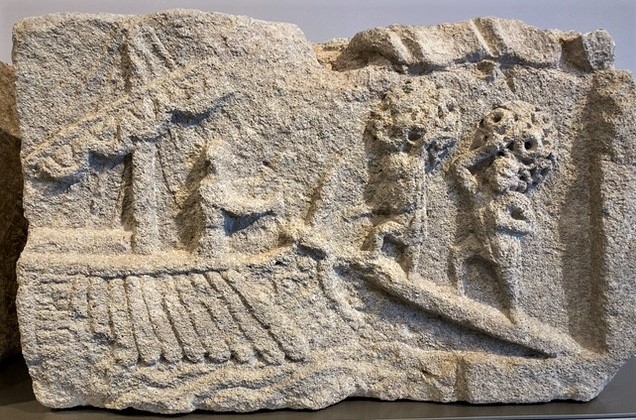
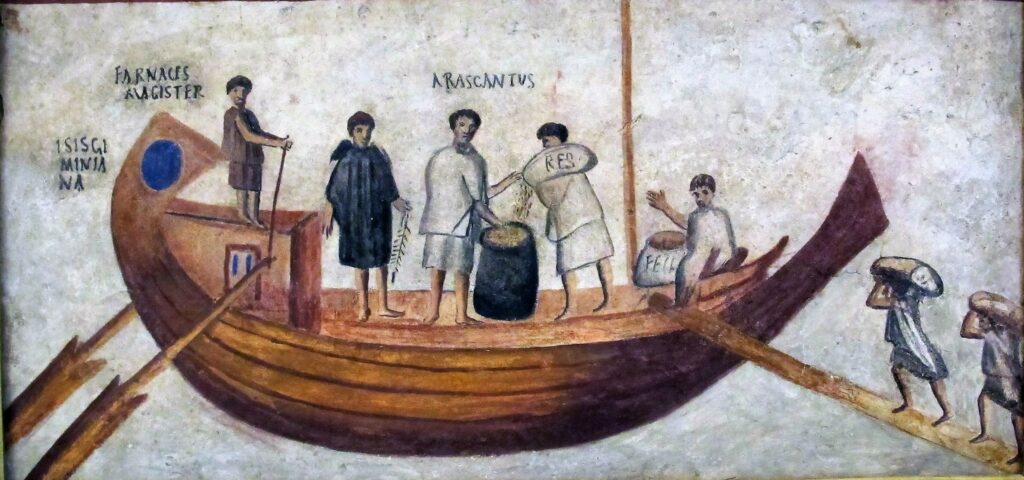
Iconography shows that ships were loaded/unloaded mainly by the bow, with a gangway on the starboard side. This may induce that ships were moored in a herringbone pattern. Depending on the type of ship and on the type of load, ships would moor bow first as shown on the pictures above, or alongside the quay-wall if cranes were needed for (un)loading heavy cargo to be lifted by cranes (live animals, barrels), and even stern first in the case of Kerkouros ships on which the payload was placed near the stern. Later ships were more bulky and had no significant rowing capacity anymore, like the Roman Corbita type with 1:4 beam over length ratio, and “normal ships” ranged between 20 and 50 m for 100 to 500 tons of cargo with up to 3.5 m draught.
In order to estimate the time required for unloading a ship, let’s assume each 250-ton ship carried around 8 000 sacks of one artaba (ca. 39 l) weighting around 30 kg each. ). If unloading was organised as a continuous file of individuals, it might be possible to unload a ship within a few days, but it is more realistic to expect a minimum of 5 to 10 days for unloading a 250-ton ship and take in provisions and settle formalities. Note also that, depending on (possibly corrupt) friends the ship captain has in the port, administrative formalities may take more time and require the ship to be anchored away from the quay-walls (Brandt, 2005; Rougé, 1952).
References
BRANDT, J., 2005, “The Warehouse of the World”, A Comment on Rome’s Supply Chain during the Empire, Orizzonti. Rassegna di archeologia 6, (p 25-47).
BOUSSO, T., (1994), “Typologie des engins et techniques de pêche artisanale utilisés au Sine Saloum (Sénégal)”, Mémoire de confirmation, Doc Scientifique N° 141, Centre de Recherches Océanographiques de Dakar-Thiaroye, (114 p).
GALILI, E., et al., 2021, “The First Marine Structures Reported from Roman/Byzantine Ashkelon, Israel: do they solve the enigma of the city’s harbour?”, in “Under the Mediterranean I”, Honor Frost Foundation, edt. Stella Demesticha & Lucy Blue, Sidestone Press, Leiden, (p 195-204).
KOMAR, P., 1998, Beach processes and sedimentation, 2nd ed., Prentice Hall.
LALOË, F. & SAMBA, A., (1990), “La pêche artisanale au Sénégal : Ressource et stratégies de pêche”, Collection Etudes et Thèses, ORSTOM, Paris, (397 p).
RANKOV, B. (2012) « Trireme Olympias, the final report », Oxbow Books, (243 p).
ROUGÉ, J., 1952, “La navigation hivernale sous l’Empire romain”. In: Revue des Études Anciennes. Tome 54, n°3-4, (p 316-325).
VOTRUBA, G., (2017), “Did Vessels Beach in the Ancient Mediterranean? An assessment of the textual and visual evidence”, The Mariner’s Mirror, Vol 103:1, (p 7-29).
